Like a demon summoned by fresh blood on its altar, Wrath: Aeon of Ruin first arose at the height of the retro-shooter revival. Developed in a modified Quake engine with levels designed by contributors to mods like Arcane Dimensions, it looked set to conquer all in its path when it arrived in 2019. Its Early Access showcased amazing weapons, splattering enemies, a knotty, secret-filled hubworld, and maps you’d sell your soul for.
Then it went back to sleep for five years. In 2021, developer KillPixel admitted the project had been sorely hindered by the Covid 19 pandemic. But the full game would be out in Summer 2022. That became Spring 2023, which then became February 2024. In that time the retro shooter continued to evolve, giving us its Doom (Prodeus), its Duke Nukem (Ion Fury) and its Hexen (AMID EVIL). All the while Wrath’s presence faded, looking less like a spiritual successor to Quake, and more like a rerun of Daikatana.
Now though, Wrath is finished, and unlike John Romero’s white elephant, you can see why it took so long. This isn’t so much a first-person shooter as it is an ode to 3D level design, a dimension-hopping adventure of colossal scale and variety that bends the Quake engine into frankly obscene positions. Sadly, this is as much a criticism as it is a compliment, for in its strive to provide the grandest shooting galleries in existence, the shooting itself gets a little lost along the way.
This has nothing to do with Wrath’s fundamentals, which are all meticulously designed. The premise is typical FPS fare. You are a lone warrior known simply as Outlander travelling a forsaken realm, bid to purge the infestation of its catacombs and monuments with blade and bullets by the Shepherd of Wayward Souls. There are three episodes that take place in three different worlds, each containing five levels. From these levels you must retrieve five magical runes that will, combined, unlock a portal to that world’s boss.
Wrath’s initial hours promise gleeful FPS mayhem. Your starting weapon is a broadsword strapped to your right forearm, capable of a charged attack that propels you forward in a vicious thrust that moonlights as a double-jump. The pistol you pick up shortly after has a punch to rival most shotguns, while the shotgun sounds like you’re slamming the door on your opponent’s wretched life. Later weapons include the Fang Launcher, a chaingun that literally fires teeth, and the Crystallizer, whose charged alt-fire mineralises even the toughest foe, making them shatter under a single pistol shot.
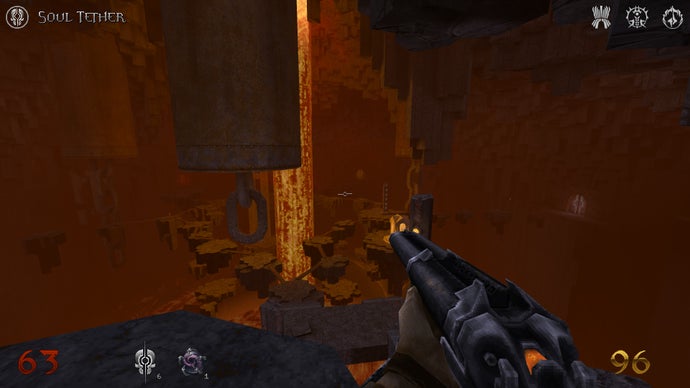
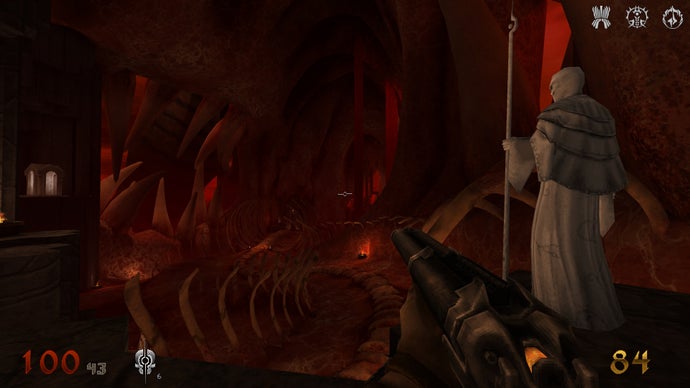
The cannon fodder Wrath trains you on is delightfully squishy too. Slow moving zombies shed an arm when you land your first pistol shot on them, then explode in a shower of giblets when you hit them a second time. Horribly mutated undead warriors will carry on fighting even after losing their heads. My favourite lowlifes are the Afflicted, walking bags of gangrene who throw globs of their own green seepage at you. Blasting these with both barrels will cause them to burst like a six-foot blister, and it’s exactly as disgusting and satisfying as that sounds.
Fun as all this is, it’s nothing that hasn’t been done in a thousand other shooters. Where Wrath stands out from the crowd is in its level design. Each of its fifteen maps is a masterpiece of 3D worldbuilding, a soaring, twisting, tunnelling, looping, writhing work of art. As each hub provides some flexibility in the order you tackle its challenges, I can’t say which you’ll encounter first. It will probably be The Undercrofts, a sprawling necropolis that weaves through snowy graveyards and subterranean sepulchres that took me 48 minutes to complete. But it might equally be The Mire, which drops you into the world’s most elaborate sewer level and forces you to climb out to a castle on the cliffside. It could even be the Gardens, an ingenious spiralling design that keeps feeding you back into its central greenhouse hub, like the world’s deadliest hedge maze.
It isn’t just the scale of these maps which astonishes (although in some, like The Burrows, it’s hard to focus on much else) it’s the loving detail poured into them. The way each room is shaped and contoured, the way its paths meander and overlap, the way KillPixel sculpts the Quake engine’s rough-hewn polygons into elegant curves and crenelations. I’m particularly fond of episode Two’s spaces, where Wrath’s vast architecture and bloody action combines with a mystical desert theme, to make you feel like Conan carving his way through some ancient, forgotten kingdom.
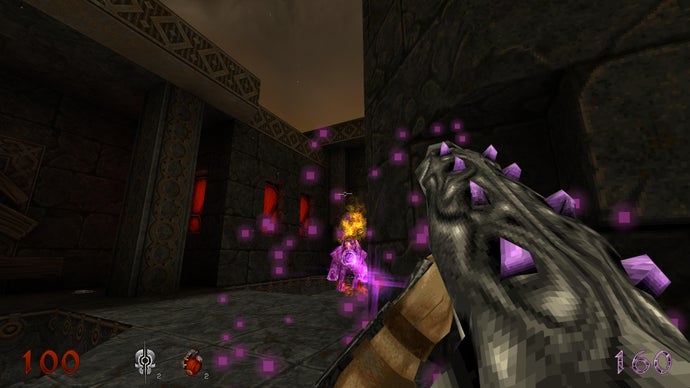
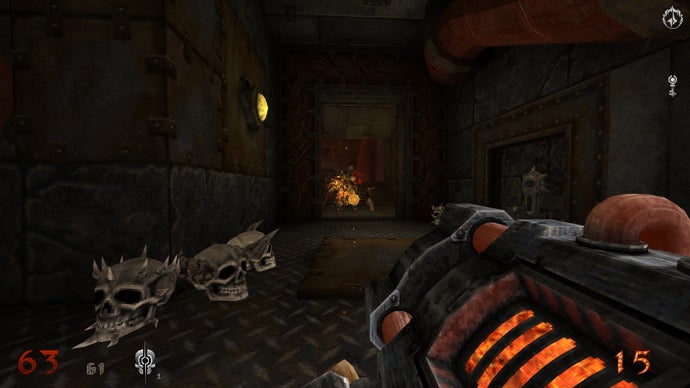
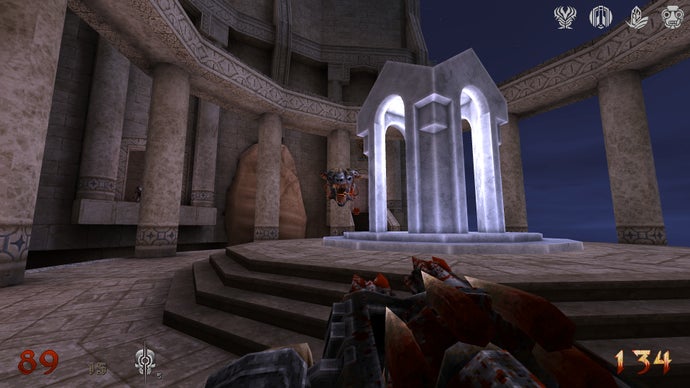
I cannot emphasise enough how much I appreciate and admire the craft in these spaces. The talent, imagination, and generosity on show is astonishing. They’re fun to explore too, riven with secrets and unlockable chests that provide bonus items you can deploy in combat, like a heart that drains health from slaughtered foes and an energy shield that deflects projectiles. But here’s where I drop the other shoe. There’s a difference between good level design and good shooter design, and for all its geometric showmanship, Wrath fails to consistently convert the former into the latter.
It took me a while to figure out why I wasn’t enjoying Wrath as much as I felt like I should have been. At first, I thought the problem lay with Wrath’s save system, which combines infrequent, single-use checkpoints called ‘Shrines’ that replenish your health, with collectible quicksave items called Soul Tethers that you can consume at will. I’ve been sceptical about this system since Wrath’s debut into early access. But now that I’ve played the full game, I can confidently say that I hate it.
For starters, limiting saves like this means that death can cost you big chunks of progress, which can make Wrath’s already huge levels feel like they’re never going to end. The bigger problem, though, is that this system meant I was constantly thinking about saving, rather than what a good time I was having turning enemies into mince. Should I save here? I’d think as I turned every other corner. What if there’s a big fight in this next room and I lose a load of health, or an ambush that kills me before I have time to react? What if there’s a Shrine just ahead and I effectively waste this save? It began to affect my approach to combat, making me reluctant to throw myself into the mix, to experiment with weapons or risk feeling out a fight.
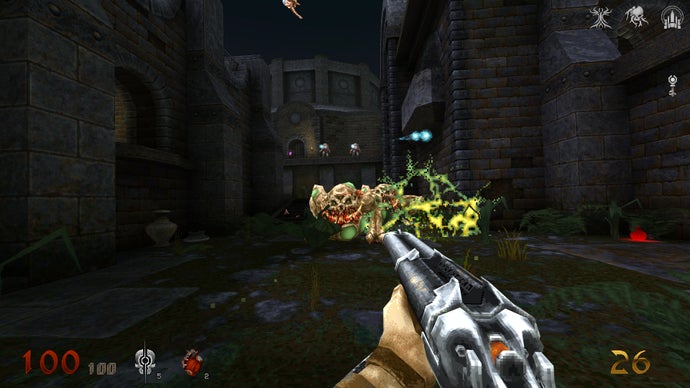
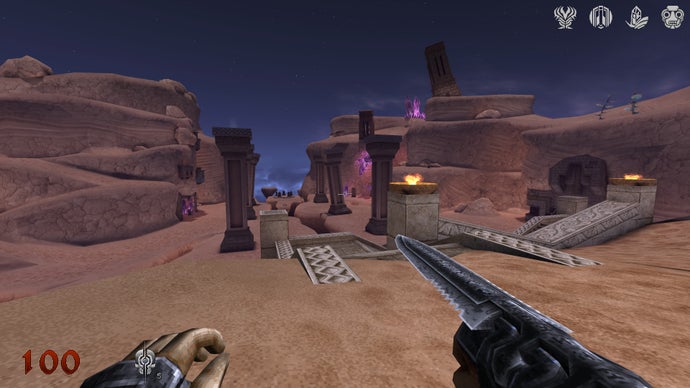
Then, about three levels from the game’s end, I discovered an option that enables infinite saves. I’ve never checked a box so hard in my life, and it unquestionably improved the experience. Now I could throw myself into combat freely, enjoy the challenge of the fight itself rather than fretting over resource management. But it didn’t instantly solve the problem as I expected to. Eventually, I realised that Wrath’s save system is merely symptomatic of a broader issue, which is that Wrath doesn’t always know how to build exciting combat encounters into its massive levels.
It’s a difficult problem to explain, but it ultimately comes down to flow. In a shooter like this I want to be in the middle of a snarl of enemies, weaving and ducking and leaping to avoid their projectiles. Wrath’s combat can be like this, but it’s generally more staggered and incremental. You’re either moving forward in staccato beats to shoot two or three enemies at a time, or peeping around corners to snipe foes positioned at vast distances.
I don’t mind the former too much. In fact, Wrath can be really fun in this mode, frequently deploying two of my favourite enemies to keep you on your toes. The Widow is a shrieking hag with teeth running down to her navel who rushes you from behind corners. She’s great fun to counter with a close-range shotgun blast or timed blade thrust. Then there’s the Prowler, a spider-like creature that can turn invisible as it scuttles around rooms, each of which provides a quickfire game of hide and seek that always ends in a satisfying mess.
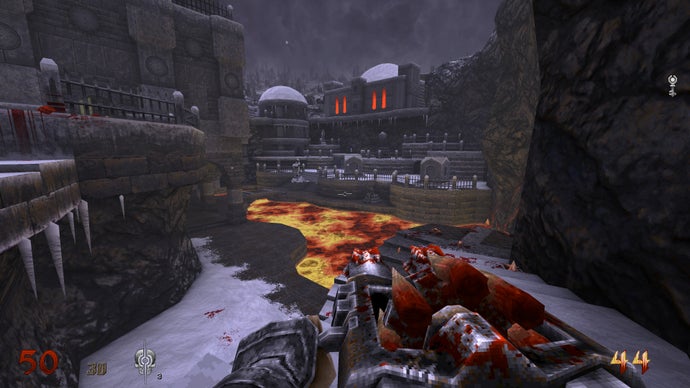
The corner peeping, however, is a real pipe between the spokes. There’s one enemy called the Wretch that I grew to utterly despise. Imagine if Doom’s imp spammed its fireball attack every half second, then imagine you had to noscope one of the little parasites from across the map every ten seconds. They’re not especially hard to kill, but Wrath scatters them everywhere, turning large sections of the game into miserable sharpshooting gauntlets where you’re just trying not to lose too much health in the process of clearing them out.
Some levels are better at pacing than others. Shadow Pantheon is the most tedious, a seemingly infinite sprawl of meandering corridors that has little verticality, few notable encounters, and no memorable moments. The Priory, by comparison, manages its scope best. It’s a huge level, but it compartmentalises that scale into clearly defined sections, building interesting combat encounters in each of those areas. There’s the initial exploration of the complex perimeter, followed by a gnarly battle through its intricate living quarters. Then there’s an uphill fight through the watchtower to open the main gate, culminating in a big twist that introduces a new weapon and a new movement system.
My favourite level, though, is Twilight Archives, as it’s where Wrath most feels like a spiritual successor to Quake. It’s a classic three-pronged affair, where you venture along a trinity of routes to throw three switches that unlock the rune in the central hub. It’s the shortest level in the game (though still substantial at 25 minutes) as well as the humblest, taking place entirely indoors in a nondescript brown maze. But it’s filled with fun traps, tightly designed combat encounters, and a neat gimmick that revolves around invisible platforms. It’s excellent.
Wrath: Aeon of Ruin can be a frustrating, exhausting experience. But in levels like The Priory and Twilight Archives, it’s as thrilling as any retro-shooter around. And weary as some of its levels made me feel by their end, I’d always jump straight into the next portal, simply because I knew there would be wonders to behold. There is something demonic in making a pact with this game. It never quite satisfies in the way I’d like it too, but its promises are just too good to resist.
A copy of Wrath: Aeon of Ruin was provided for review by 3D Realms.
